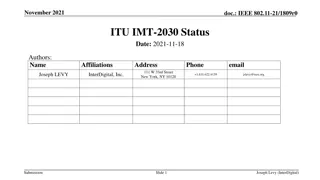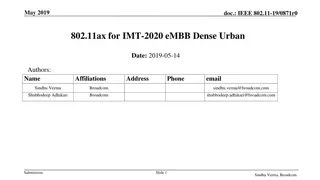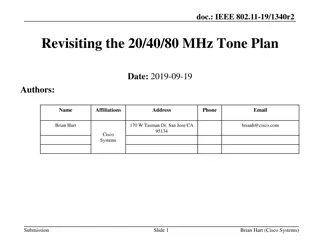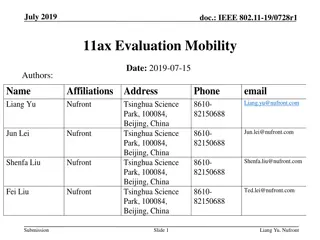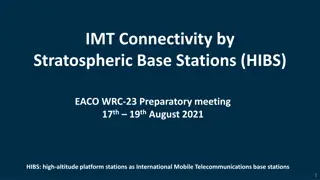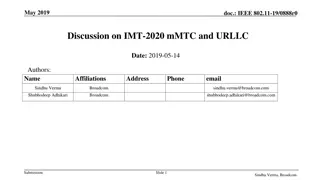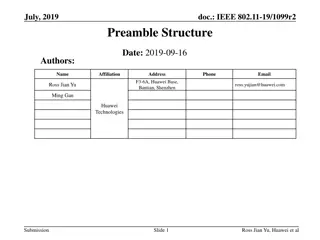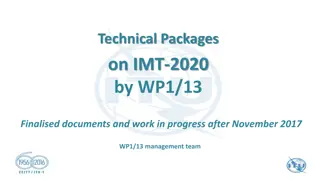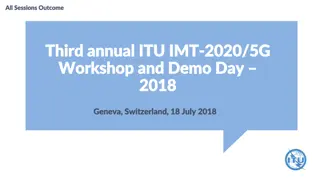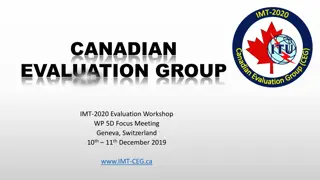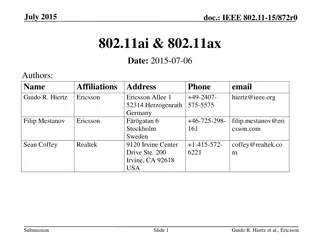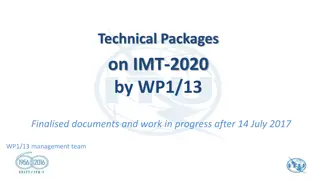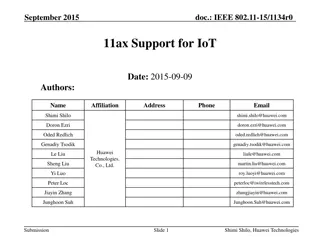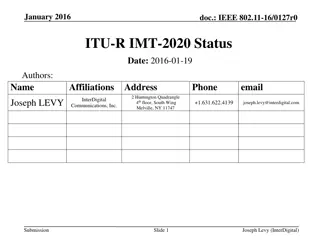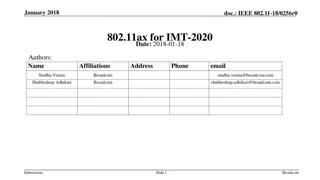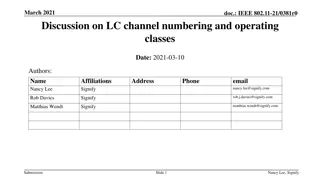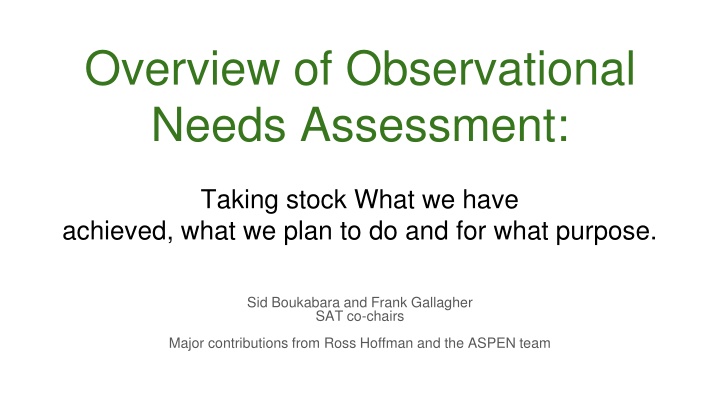
Analysis of 802.11ax vs. IMT-2020 Requirements
This document provides a detailed comparison of 802.11ax capabilities with the IMT-2020 requirements for different scenarios like eMBB Indoor Hotspot and Dense Urban settings. It also discusses features in other unlicensed spectrum technologies and proposes how 802.11ax can meet the IMT-2020 demands.
Uploaded on | 1 Views
Download Presentation

Please find below an Image/Link to download the presentation.
The content on the website is provided AS IS for your information and personal use only. It may not be sold, licensed, or shared on other websites without obtaining consent from the author. If you encounter any issues during the download, it is possible that the publisher has removed the file from their server.
You are allowed to download the files provided on this website for personal or commercial use, subject to the condition that they are used lawfully. All files are the property of their respective owners.
The content on the website is provided AS IS for your information and personal use only. It may not be sold, licensed, or shared on other websites without obtaining consent from the author.
E N D
Presentation Transcript
Overview of Observational Needs Assessment: Taking stock What we have achieved, what we plan to do and for what purpose. Sid Boukabara and Frank Gallagher SAT co-chairs Major contributions from Ross Hoffman and the ASPEN team
What was done so far: - - Discussing the Driving applications (discussion led by Mitch) Collected Global NWP Observational Needs Next steps: - Review other GNWP needs as collected by XORWG, TPIO, UE at the core- SAT Review and codify these GNWP needs into signed memo for future reference Extend the assessment to future GNWP needs: Talk in progress with OAR/NWS UFS folks and with Future NWP WG Based on previous SAT driving applications discussion, we plan to Extend the assessment of observational needs to (1) nowcasting (2) air quality and (3) oceans. See discussions in this SAT meeting - - -
For what purpose? (are we collecting these observational needs)
For what purpose? Enterprise Approach: - Needs should be assessed in a comprehensive fashion from users, independent of specific solutions Funnel existing obs needs, consolidate/review/codify - Driving the next-gen Architecture: - Needs will be reviewed internally in NOAA. These will impact what gets adopted as requirements, to be put in the PLR of the space programs Architecture Evaluation (performance assessment/validation) and optimization: - Use of ASPEN tool - Use of SAT (and formal recommendation using core-SAT) as a mechanism to review ASPEN tool science results
Example: GEO-XO Constellations Assessment: Case of 22 Constellations - Comparison of 17 out of 22 constellations Using 6 example applications: (Fire, GNWP, Hurricane, Regional NWP, Severe Storms, Coastal water) Const 1, 2 and 2025 have the lowest benefit, consistently. Other Constells seem to have relatively similar performances & benefits Costs however seem to be a defining factor for those 17 constells - Benefit Assessment of 17 constellations (mesoscale mode) Benefit Assessment of 17 constellations (NOAA mission) - - - Bottom Line: Based on these preliminary results, when rolled up to the NOAA mission level, constellations 1 (highest) 3,8 and 20 seem to have the highest values for many applications. These results do generally hold at individual applications, but not all. Constellation 16 seems to have the lowest value. 7
N A T I O N A L O C E A N I C A N D A T M O S P H E R I C A D M I N I S T R A T I O N Assessment of ASPEN: How trustable is ASPEN evaluation? FSOI FSOI FSOI-based assessment Intercomparison (UCAR/JCSDA) showing variability of FSOI results between centers and between sensors FSOI FSOI ASPEN ASPEN-based assessment showing overall compatibility of ASPEN results with FSOI
N A T I O N A L O C E A N I C A N D A T M O S P H E R I C A D M I N I S T R A T I O N Things to keep in mind Going forward Comprehensive approach is important: democratization of the assessment process. Keeping the observational needs solution-agnostic is important to truly explore the most optimal solutions offered ASPEN is just a tool. SMEs expertise is critical for the interpretation Distinction between observational needs and sensors specifications (a later stage step) Observational needs means: observables, their attributes, and their priorities, their uncertainties (if known), for different applications within a domain. Ultimately, domain experts should also provide us with assessments of the priorities of different applications within a domain We do realize it is a major undertaking with potential obstacles, but it is a worthwhile undertaking: to optimize the NOAA next gen space architecture - - - - - - -

